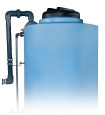For over five decades, Poly Processing has been at the forefront of innovation in chemical storage tank design and manufacturing. Reinforcing our commitment to advancing crosslinked polyethylene (XLPE) tank technology, we are proud to offer our largest storage tank solutions: the 15,500-gallon IMFO® Tank, the 15,000-gallon Sloped Bottom IMFO® Tank, and the 15,500-gallon Vertical Tank. All are available in specific gravities up to 2.2 design.
Topics:
News and Customer Stories,
Tank Design and Materials
Secondary containment is an important safeguard that helps plant operators mitigate the costly risks of chemical spills. Many companies are realizing the business advantages of switching from open-top tanks and concrete basins to a fully enclosed double-wall containment system. When our customers are weighing their options, they usually have several questions about double-wall containment. Here are some of the most common questions and answers about double-wall containment systems.
Topics:
Tank Design and Materials
When it comes to storage solutions for liquids, high density crosslinked polyethylene (XLPE) storage tanks are an excellent choice due to their durability, corrosion resistance, versatility and useful life. If you're considering investing in an XLPE storage tank, it’s crucial to understand the complete journey from ownership to retirement.
Topics:
News and Customer Stories,
Tank Design and Materials
Although it's impossible to know what the exact lifespan of your polyethylene tank will be, there are steps you can take to extend its life in order to get the most out of it.
Topics:
News and Customer Stories,
Tank Design and Materials
Maintaining the proper temperature of a chemical inside a high density crosslinked polyethylene tank can be critical for safe and effective storage. For example, sodium hydroxide and caustic soda need to maintain temperature to prevent crystallization at lower temperatures.
Topics:
News and Customer Stories,
Tank Design and Materials
Storage tank accessories and fittings are often seen as extra add-ons that get little consideration — as if they were nice-to-have features like heated seats in a new vehicle. However, these are critical components of a successful storage system. The useful life of your chemical storage tank can be greatly impacted by your choice of fittings and accessories.
Topics:
News and Customer Stories,
Tank Design and Materials
This article is part 2 of a two-article series that provides an overview of some important industry and regulatory compliance issues you should be aware of when purchasing a chemical storage tank. Read the first article of this series to learn about ASTM and NSF/ANSI/CAN 61 standards.
Topics:
News and Customer Stories,
Tank Design and Materials
This article is the first in a two-part series that provides an overview of some important industry and regulatory compliance issues you should be aware of when purchasing a chemical storage tank. This series doesn’t cover an all-inclusive list of compliance regulations, but you can use the articles to give you a confident start in understanding the requirements to consider when purchasing a chemical storage tank.
Topics:
News and Customer Stories,
Tank Design and Materials
One of the challenges in storing any oxidizing chemical is engineering a chemical storage tank that not only contains the chemical but has a greater useful life and measure of safety. Whether you’re storing sodium hypochlorite, sulfuric acid, hydrochloric acid, or other oxidizing substances, it is critical to design the storage tank with the chemical in mind.
Topics:
Tank Design and Materials,
FAQs
Proper chemical storage is an important aspect of operating a plant or facility. In order to ensure that chemicals are stored safely in polyethylene tanks, you have to choose or custom-build a tank with the correct wall thickness. But what goes into determining the correct wall thickness for your chemical storage tank?
Topics:
Tank Design and Materials



